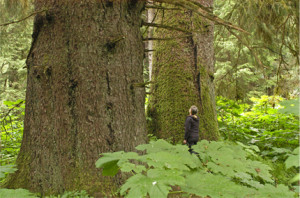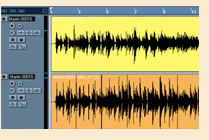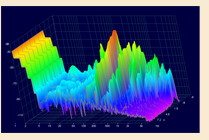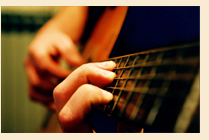The A01™ Process

Let’s talk about taking a great guitar and transforming it into an incredible guitar.
To do that, we need to first discuss the all-important role of wood.
Regardless of brand, the quality of the top wood is the most important factor in the tone of any acoustic guitar. A mediocre guitar will never change or be modified into a world-class instrument. When you hear an incredible-sounding vintage acoustic guitar, its tone is significantly indebted to having a great top. Period.
The top wood of a guitar accounts for 90% of the tone, and is quite simply the “voice” of your guitar. Voicing is a tonal outcome that combines variables such as the quality and species of top wood, the build process, aging, playing and environmental changes.
Wood contains tube-shaped cells that absorb moisture when its humid and expel moisture when its dry. Wood shrinks or swells depending on climate and time of year. The hollow cells store the moisture.
Over an extended period of time these cells naturally tend to collapse, which limits how much moisture the wood cells can absorb. When this occurs, the wood becomes more stable and reaches a state of equilibrium, with the guitar top becoming dryer, lighter and stiffer. Generally speaking, the lighter and stiffer a top is, the better its “voice.”
Your guitar was first a tree, and for a lot longer than it has been a guitar. Though now a guitar, the cellular polymer properties of the wood are still acting like it’s a tree. This does not produce the optimum voice that the same guitar will offer many decades down the line.
So a great instrument that is played regularly and has become stiffer and lighter with age may end up with remarkable voicing. Because of the scientific nature of wood, a newly constructed guitar simply cannot produce this level of voice.
But we’ve changed that. Not with magic or mystery, but with sound science.
In a nutshell, the AO1™ process takes the top wood of not-so-old guitars and other hollow stringed instruments and makes it forget that it was ever a tree. The result is an significant increase in dynamic range, playability, volume, richness and tonal balance. Through our multi-stage process, we assist guitars in finding their true “voice.”
Now for some science. Playing the strings (and the resultant vibrations between the bridge and the top wood) creates certain amplitude oscillations, but only in what we call the “sound-forming surfaces” of the guitar. But not all of the top wood is an equally conductive surface. The varying cellular structure of the polymer (aka wood) sees to that. You can play your guitar as hard as you want, but there is a limit to the amplitude that the sound-forming surfaces can handle. The rest falls on deaf ears, so to speak.
The AO1™ process first identifies, then targets specific areas–the sound-forming surfaces–of the top wood. Precise scientific instrumentation maps the degree and location of each note on the sound-forming surfaces of the instrument. The result is a unique computerized “fingerprint,” or map, of the top wood dynamic response. From there, discrete wave forms (often complex) are programmed to stimulate specific regions of the top wood.
Once a guitar is “mapped” and stimulated, the guitar is then re-measured and re-mapped. With each new map comes a corresponding precise and prescribed stimulation. This process is repeated three or four times over the course of approximately ten days. The energy stimulation (or “excitation” if you like) of the guitar is extremely specific in frequencies and very selective in the location of the stimulation.
Those responses are then used to establish unique process parameters that will be implemented on each individual instrument. No two instruments are the same, and the AO1™ process is custom-calibrated for every guitar. We take the time to really get to know your instrument before subjecting specific sound-forming surfaces to the stimulations necessary to optimize your instrument.
The guitar (or violin, mandolin, cello, etc.) is placed in an anechoic chamber and scanned by a proprietary sensor system that maps the input and output response of the primary sound-forming surfaces of the instrument–the top wood. Those responses are then used to establish unique process parameters that will be implemented on each individual instrument. AO1™ is a precision-tested and calibrated process that targets and affects each musical instrument differently, based on the intrinsic qualities of the wood of that instrument which are revealed during our scientific gauging process.
By safely and permanently altering the molecular structure of the wood, we are able to increase the resonant amplitude of the instrument, giving it more sustain and increased volume while balancing the dynamics and making it easier to play.
The end result of the AO1™ process is permanent and acoustically exceeds what normal playing and age alone or together can accomplish.
Another term we use for the AO1™ process is “ultra-seasoning.” We do not age wood.
What the patented AO1 Process™ does NOT involve:
- Shaving or cutting
- Humidity changes
- Removal of any wood or material
- Chemical treatments
AO1™ does not alter the color or tone of an instrument. If a guitar is deep and woody, it will remain deep and woody. If it is bright and crisp, it will remain bright and crisp.
This is still the guitar that you selected above all others, that you play and love. With AO1™ it just plays and sounds better. It’s everything today that your guitar would otherwise be someday.
All of our customers are not just happy with the results–they are happy by a wide margin. See some of our testimonials.
More Science
The AO1™ process allows for symmetrical, properly located oscillations to occur in the sound-forming surfaces of the instrument and manifests itself in greater volume/dynamic range, richer, more full sound, and greater responsiveness to the player’s touch. Over the course of the following four-to-six weeks after receiving your optimized instrument, the instrument will continue to transform until it reaches its full potential, gently assisted by your frequent playing.
Like its player, every guitar is unique. The maps we generate really illustrate this point. Therefore, there is no one-size-fits-all approach to acoustic optimization, or ultra-seasoning. The magnitude of stimulation varies greatly for each sound-forming surface location and note. This provides the best possible balance while maximizing dynamic range and increasing the responsiveness to the player.
To date, we have recorded proven, quantifiably-graphed improvement on 100% of the guitars we’ve processed. Every single instrument to which we’ve applied the AO1™ process has improved within the following parameters:
 Increased Resonant Amplitude – The overall volume on the guitars comes up. This is recorded and observed by waveform analysis using a digital oscilloscope before the process is applied to form a baseline. The exact analysis is again performed and measured after the AO1™ process. Increased Resonant Amplitude – The overall volume on the guitars comes up. This is recorded and observed by waveform analysis using a digital oscilloscope before the process is applied to form a baseline. The exact analysis is again performed and measured after the AO1™ process. |
|
 Increased Dynamic Range – In addition to overall volume, the process also brings up “dead spots” in the dynamic range of the note spectrum. This is as close as the process gets to affecting something like “tone.” Though not precisely what musicians call “tone,” the process is capable of uncovering a “sparkle” or bell-like quality in the highest end or a series of subtle overtones or harmonics that were less present before the process. Imagine striking a bell with a cloth dampening it. Now imagine removing the cloth and striking it again. Same bell, more sound. Increased Dynamic Range – In addition to overall volume, the process also brings up “dead spots” in the dynamic range of the note spectrum. This is as close as the process gets to affecting something like “tone.” Though not precisely what musicians call “tone,” the process is capable of uncovering a “sparkle” or bell-like quality in the highest end or a series of subtle overtones or harmonics that were less present before the process. Imagine striking a bell with a cloth dampening it. Now imagine removing the cloth and striking it again. Same bell, more sound. |
|
 Increased Articulation – In some guitars, the AO1™ process brings out an effect not unlike that of an acoustic compressor, or, more accurately, the classic compressor/expander combination. Whereas notes on an unprocessed instrument can be tracked with a typical Attack, Decay, Sustain, Release (ADSR) curve, a processed guitar will show a much more complex behavior pattern which will often rise again within the normal cycle. This creates an effect that seems to redouble and gain from its own amplitude, somewhat like a wave. This produces an increased sustain aspect, especially noticeable in registers of the instrument that previously decayed more quickly due to inherent physical limitations. Increased Articulation – In some guitars, the AO1™ process brings out an effect not unlike that of an acoustic compressor, or, more accurately, the classic compressor/expander combination. Whereas notes on an unprocessed instrument can be tracked with a typical Attack, Decay, Sustain, Release (ADSR) curve, a processed guitar will show a much more complex behavior pattern which will often rise again within the normal cycle. This creates an effect that seems to redouble and gain from its own amplitude, somewhat like a wave. This produces an increased sustain aspect, especially noticeable in registers of the instrument that previously decayed more quickly due to inherent physical limitations. |
|
 Decreased Player Fatigue – This is one of the effects of the process that is easy to understand but harder to quantify. We create volume with our hands, fingers and arms. After the process, we are using less energy to produce the same volume when fretting, strumming, gripping etc. Therefore, we find ourselves able to play for an extended period of time with less player fatigue. Decreased Player Fatigue – This is one of the effects of the process that is easy to understand but harder to quantify. We create volume with our hands, fingers and arms. After the process, we are using less energy to produce the same volume when fretting, strumming, gripping etc. Therefore, we find ourselves able to play for an extended period of time with less player fatigue. |
Our patented AO1™ process also includes trade secrets that frankly we’re not inclined to give away on this website. We will state that our proprietary (and confidential) process is 100% science-based and while astonishing, is not illusionary. See what our clients have to say about their guitars after being ultra-seasoned with our science by reading client Testimonials on the AO1™ process.

Leave a Reply